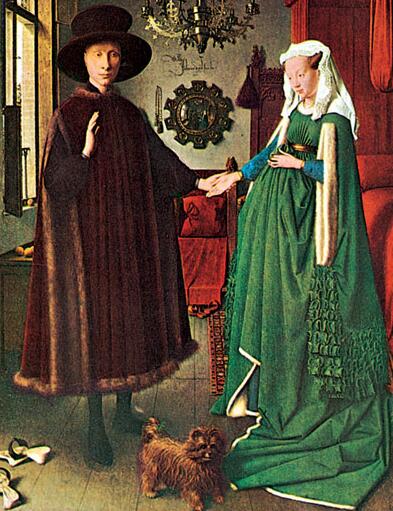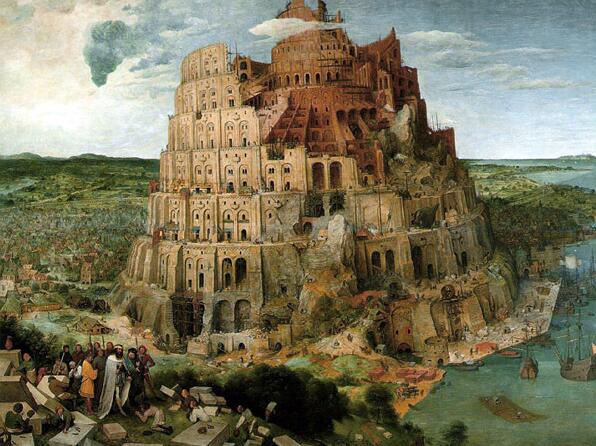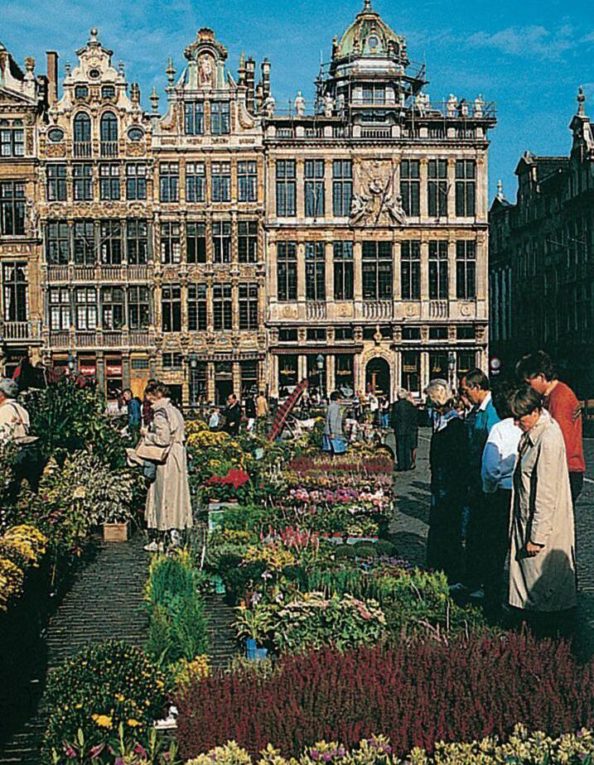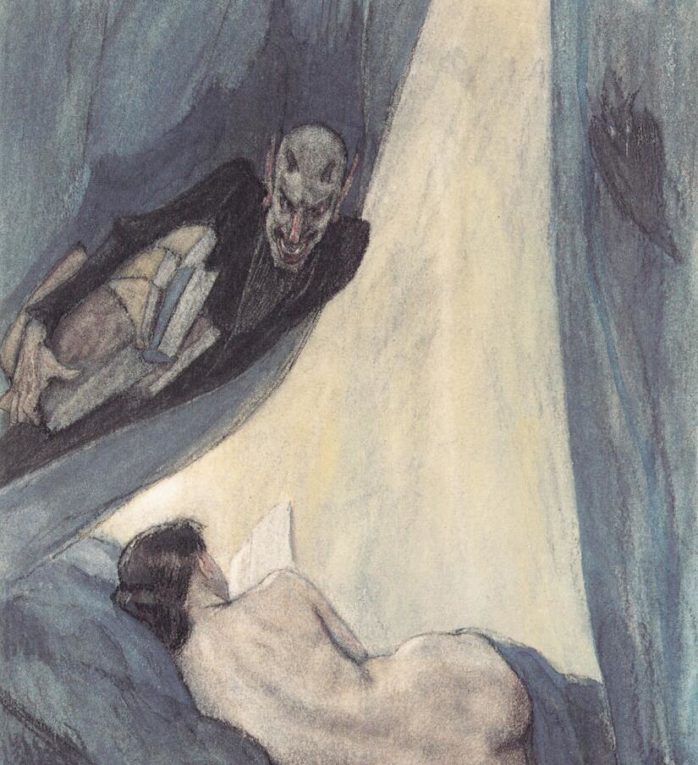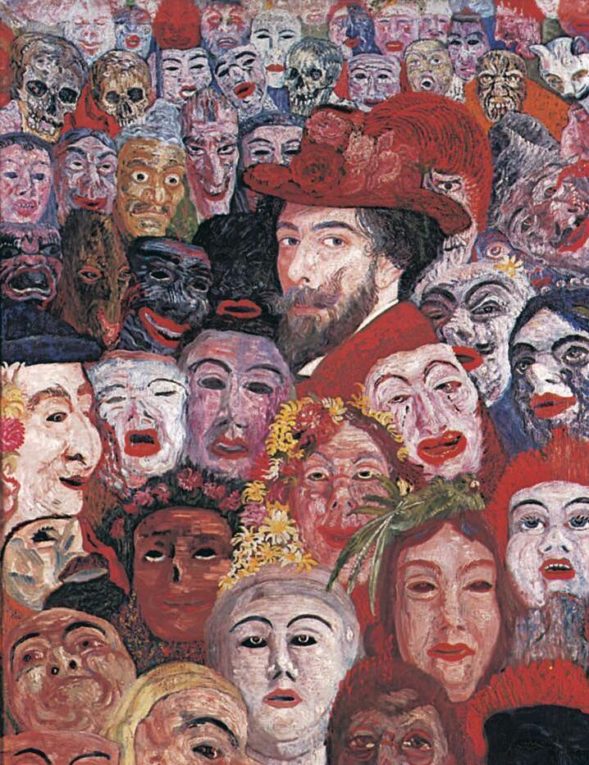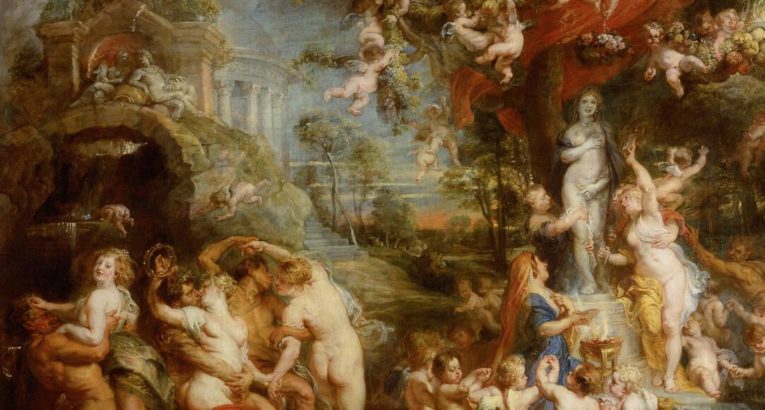The art of the area that is today Belgium, like the other cultural expressions, has two main components, one French-dominated and one more domestic Flemish. Until the division of the Dutch provinces in 1581, one speaks of a common Dutch art, where the southern Dutch in particular received impetus from French and Italian cultural territory – the so-called Romanism – and the northern Dutch represented a more homely, sometimes German-speaking tradition, with no sense of the monumental, and strongly concerned with the close-up of daily life (see also Art in the Netherlands).
In painting and sculpture, the period in the southern provinces, from 1581 onwards to the Belgian state formation, is called Flemish; however, the Flemish tradition lives on in Belgian art right into our century.
1200-1400 century
One of Belgium’s central medieval architectural monuments, the Gothic Cathedral of St. Gudula in Brussels. It was built in the 13th century. The towers are slightly over a hundred years younger.
Medieval architecture in Flanders includes central buildings such as the Cathedral of Tournai and St. Michel in Brussels, both strongly influenced by French Gothic; the cathedrals in Bruges and Antwerp, the sales halls in Ieper and the town halls in Bruges, Brussels and Leuven all represent a national and original brick gothic. The sculpture is primarily represented by works of decorative art, such as tomb monuments and church decor. Its greatest master was Claus Sluter, active in Dijon circa 1400, in a heavy, yet expressive, realistic style. Among the most important works were cut altars exported from Antwerp and Brussels to the whole of Northern Europe. The painting got its earliest expression in book illumination. In this area, the main work was the Limbourg brothers’ miniatures for the Très riches Heures du duc de Berry (1411–16).
1400-1500 century
Painting from 1434. National Gallery, London.
Painting from 1563. Kunsthistorisches Museum in Vienna.
The creators of the Flemish painting were otherwise the brothers Hubert (c. 1370–1426) and Jan van Eyck (c. 1390–1441), who were active in Ghent and Bruges and who in their famous Gentalter created a hitherto unknown realism in the material with a intimate nature study, psychic characterization and lyrical landscape portrayal, all expressed in a fine color and light treatment. Also important was their improvement and application of the oil color technique.
Among the great painters of the century were also Dirk Bouts (c. 1420–1475) and the boldly realistic Flémall master (probably identical to Robert Campin, c. 1430). His student again was Roger van der Weyden (c. 1400–1464), who created a dramatic religious mood. The highlight was reached with Hugo van der Goes (dead 1482), who shows both dramatic power and sharp realism in his famous Portinarias, which originated in Italy. A more lyrical touch is found in the German-born Hans Memling (1440s-1494). His portraits also show Italian influence, as does Gérard David (death 1523), which had a certain significance for the development of landscape painting.
At the end of the 16th century, the political and economic conditions for the southern provinces were not the best. Antwerp’s economic hegemony was broken, and the Scheldt estuary was blocked by the northern provinces. But the ecclesiastical and dynastic relations with Italy, Spain and Austria provided artistic impulses which, together with the counter-Reformation, should make their mark on the art in this area.
The Italian direction dominated in painting with Frans Floris ‘ students in the lead. However, the national uniqueness that had reached the breakthrough of Pieter Brueghel the Elder continued with his son Pieter Brueghel the Younger (1564-1638). The last part of the 16th century is by no means dominated by the struggle between Romanists and national traditionalists. In landscape painting, Gillis van Coninxloo and Bril are on the transition from the fantasy landscape to the more realistic 16th century, and with Bril and Joos de Momper to the heroic landscape. Among the former genre painters is Pieter Aertsen.
1600s
Brussels Belgium. The capital of Brussels has many old building environments. The picture is from the Grand Place / Grote Markt with the famous series of pool houses from the 1600s.
Landscape with thunderstorms or Jupiter and Mercury with Philemon and Baucis. Painting in the Kunsthistorisches Museum in Vienna.
However, when Peter Paul Rubens (1564–1638) returned home in 1608 and settled in Antwerp, he consolidated Flemish art and provided a mighty flourish. As versatile and enterprising as he was, he mastered the various sides of his metier and satisfied through his large workshop a very substantial part of the church’s and aristocracy’s need for paintings, so that his studio actually became both the center and the college of the country’s art.
Rubens collaborated with the wild and still life painter Frans Snijders (1579–1657), the flower painter Jan Brueghel the Elder or “Fløyels-Brueghel” (1568–1625), the landscape painter Lucas van Uden (1595–1672), and among the most important of the Rubens students were Anthonis van Dyck (1599–1641), who unfolded his greatest business in England. He also commissioned copper sticks to reproduce his compositions. These formed a school that in its time moved to Paris and became the basis of modern copper engraving. And thanks to his cartons for magnificent wallpapers, the famous picture weaving in Brussels had a renaissance.
All Flemish art, including sculpture and architecture, was more or less influenced by Rubens in the 1600s. His competitor, the prolific altar painter Gaspar de Crayer (1584–1669), was quite strongly influenced. Representatives of the older specific Dutch tradition, however, were portrait painter Cornelis de Vos (1585–1651) and Jacob Jordaens (1593–1678), who claimed their own robust folk, especially in their everyday depictions of life. In this area Frans Hals ‘ pupil Adriaen Brouwer (1606–1638) worked with even greater originality, while David Teniers the younger(1610–1690) with its meticulous presentation, the existence of the subclass showed how it tasted a remotely interested aristocracy. By contrast, Jan Siberecht’s (1627-1703) landscapes with scenes from the fairy tale had a more authentic character. A student of Frans Snijders was the hunting and still life painter Jan Fyt (1611–1661). Gonzales Coques (1614–1684) painted like van Dyck, most noble people, and got Theodore Boeyerman’s (1620–1678) as his most prominent successor.
After the struggles of religion and all that the Catholics were allowed to rebuild, church building had a rich time. The main monument was the Jesuit church in Antwerp, which was built in 1614–1621 by Pieter Huyssen (1577–1637) with a wide sculptural ornate facade. The foremost architects included both Rubens’ opponent Venceslav Coebergher (1561–1634) and his friend Jacques Francquart (1577–1651). After the Brussels bombing in 1695, the Grand ‘place square got its glorious shape with the guilds’ many new, rich and imaginatively decorated gable houses in addition to the one that stood alongside the town hall.
1700s
Again in this century, European art gained valuable contributions from Flemish abundance through a number of painters. The first half was marked by the setback after the great period. Classicism had a rousing effectin the middle of the century. It first appeared in the sculptor Jacques Bergers (1693-1756) fountain on the Place du grand sablon in Brussels (1752) and was carried on in the sculpture by the sentimentally tame Lambert Godecharle (1750-1835). Within the painting, Andreas Cornelis Lens (1739-1822) paid tribute to the strict French style, landscape and sheep painter Balthazar Ommeganck (1755-1826) a mild-mannered naturalism. Willem Jacob Herreyns (1743–1827), on the other hand, sought connection in the old traditions, as did Pieter Verhaegen (1728–1811) and Jean-Louis de Marne (1744–1829), who had Rubens and Teniers respectively.
In architecture, the Frenchman Hector Guimard was a pioneer with stylish facilities such as Place royale and Rue royale and several monumental buildings. By his side appeared Louis Joseph Montoyer and Payen the elder, who together built the castle Laeken (1782–1784). Following were van der Straaten, who was the architect of the Royal Palace in Brussels (1820), the master of the University of Ghent (1818-1826), Louis Roelandt (1786-1864) and Tielman Frans Suys (1783-1861), who among others another built the large greenhouses in Brussels (1826) in an iron and glass structure that informed the modern era.
19th Century Visual Art
Félicien Rops was known for his erasures that deal with macabre motifs from the spheres of eroticism, death and cargo.
Fernand Khnopff was a Belgian painter, graphic artist and sculptor, among the country’s most important symbolists. Painting from 1896.
French influence in Belgian painting is particularly strong after the nestor of classicism in French art, David, settled in Brussels, while the Academy of Fine Arts in Antwerp was led by the classically interested van Brée (1773-1839). Especially François Joseph Navez created on this basis an outstanding portraiture, rigorous and yet expressive. He is then also regarded as the founder of modern Belgian painting. After all, however, the French romance was more in tune with the Belgian spirit. Gustaaf Wappers portrayed Belgium’s independence struggles in Eugéne Delacroix ‘s style, and Louis Gallait created immense and powerful history paintings.
A peculiar figure among the romantics was Antoine Wiertz, who technically worked in Rubens’ spirit, but who with his partly morbid imagination can be called an early precursor to surrealism. A significant painter of history was Hendrik Leys, technically inspired by German 16th century art, motivationally a kind of precursor to the prerafaelites. An elegant, saloon portrait painter was Alfred Stevens, who lived in Paris for much of his life.
Only after the middle of the century was a Belgian painting created that stood on safer national grounds. With folk tales inspired by seventeenth-century masters, Henri de Braekeleer brought a new realistic spirit into the painting, but he was also a fine colorist and particularly concerned with the light problem.
The new realism, with a certain social appeal, otherwise found its strongest expression in Charles De Groux and in paintings by the sculptor Constantin Meunier. The realistic landscape art of the Barbizon school got a parallel in lyrical images of Hippolyte Boulenger, while Emile Claus, with her sense of light and atmosphere, was eventually strongly inspired by French impressionism. In close contact with French art, Félicien Rops also stood in her imaginative, technically excellent and often erotic erasures.
Towards the end of the century, Belgian art life became increasingly intense and rich. A number of exhibitions by French artists were organized in Brussels, including the important art association Les XX, founded in 1883. Strong impressionistic impulses prevailed at Jakob Smits, but his art has a peculiarly realistic weight. The same applies to Valerius de Saedeleer and not least to F. Laermans, who created a powerful, socially emphasized depiction of human need. A more traditional realism represents portrait painter Isidore Opsomer. Theo van Rysselberghe introduced neo-impressionism in Belgium.
In sculpture, Gilles Lambert Godecharle (1750-1835) was the leader at the turn of the century. Later sculptors were Paul de Vigne (1843–1901), Charles van der Stappen (1843–1910) and Julien Dillens (1849–1904) and the neo-baroque Jef Lambeaux (1852–1908). Still, the greatest sculptor of the century is Constantin Meunier (1831-1905). The monumental sculptor Thomas Vincotte (1850–1925) also made his mark on Belgian sculpture around the turn of the century, while the most typical representative of the flow just around 1900 was Georges Minne (1866–1941).
20th Century Visual Art
James Ensor. Self portrait with masks. Painting, 1899. Royal Museum of Fine Arts, Antwerp.
The first great painter of modern Belgium was James Ensor, whose stunning, often grotesque images have an unparalleled coloristic richness and an expressionist strength that has led many to align him with van Gogh and Munch.
Another forerunner of modern art in Belgium was Henri Evenepoel, who developed an impressionistic expression into a richness of color that ushered in fauvism.
Significant to the development were also the two Laethem-Saint-Martin groups, the first with Gustave Van de Woestijne, the sculptor Georges Minne and Albert Servaes as foreground figures – champions of a symbolic, mysterious art; the other consisted of Gustave de Smet, Frits van den Berghe and, above all, Constant Permeke, representative of an unusually independent and powerful expressionist painting. In connection with this group can be mentioned Edgar Tytgat and the graphic artist and book illustrator Frans Masereel, while Jan Brusselmans has found a more constructive form of expression.
Belgium also has outstanding representatives when it comes to modern art directions. Two of the most prominent and prominent figures in Surrealism, for example, were Belgians: René Magritte and Paul Delvaux, and in abstract art can be mentioned LV Ling, Marc Mendelsohn and Victor Servranckx (1897-1965).
One group of artists who had a short life, but a great influence, and whose works have been renewed topical in today’s art picture, is the multinational group COBRA (1949–1951), where Belgian representatives Christian Dotremont, Raoul Ubac, Pol Bury and Pierre Alechinsky are central also in European post-war art in general.
Another of post-war art’s most prominent Belgian artists is Marcel Broodthaers, who with his poetic-ironic works and installations filled with letter and number symbolism laid the foundation for much of European 1960s and 1970s art.
In sculpture, interest in the Egyptian is noticeable and can be found at Oscar Jespers (1887-1970). He introduces Belgian sculpture into Cubism, while Rik Wouters (1882-1906) with his dynamic motifs represents Impressionism. Ernest Wijnants (1878–1964) is Greek archaic, while Servranckx experiments with abstract sculpture. Painter Permeke also performed expressionist sculpture.
Among the leaders around the mid-1900s are the Maillol- influenced George Grard (1901–1984), then Charles Leplae (1903–1961) and Willy Kreitz (1903–1982). Of the post-war Belgian sculptors, Roel d’Haees’s expressive, expressive works and Pol Bury’s mobiles will be highlighted.
In the 1980s and 1990s, Belgian art has also produced interesting artists. Jan Vercruysse (1948–2018) and Guillaume Bijl (born 1946) both start from existing objects, which are then repositioned and commented on. Vercruysse works with furniture forms and musical instruments, which in his newly created editions add value in relation to the starting point, while Bijl in his installations almost copies exhibition windows and shop interiors, be it in an art gallery or at an art fair. Thierry de Cordier (born 1954) is the role model for his artist role as the gardener and his careful and respectful interaction with nature. His installations provide an intimate insight into nature such as hiding place, waste pile or renewal reservoir. In the painting, Luc Tuymans (born 1958) in particular has made his mark,
Architecture in the 19th and 20th centuries
Victor Horta. Hall in Herenhuis Van Eetvelde, built in 1897, a fine example of Art Nouveau architecture.
In the early 1800s, the construction style was classic, with Tilman-François Suys (1783-1861) as the leader. But he also worked in neo-Gothics, such as van Overstraeten (1818-1849), who built the New Romanesque Church of St. Mary in Brussels. At the end of the century, Belgian architecture nevertheless rises above the level of ordinary European historicalism. During the New Baroque, Joseph Poelaert (1817–79) traveled to the Palais de Justice in Brussels, completed in 1883; this building now stands as the most distinctive exponent of Europe in the direction of the Paris Opera. Alphonse Balat (1818-1905) also constructed new baroque buildings, but the national currents, together with constructive trends, were to provide a foundation for architects of international importance in Belgium.
Victor Horta (1861–1947) created the art nouveau style of Hotel Tassel in 1892–1893 and remained Belgium’s leading architect until his death, represented by buildings such as Maison du Peuple (1899, demolished 1965), Académie des Beaux Arts in Brussels (1926 ) and the central train station at the same location, completed in 1957. Next to him stands Henry van de Velde (1863–1957) who became the Art Nouveau style propagandist, and Paul Hankar (1859–1901).
In our century we find an advanced architecture in Belgium with the architect Jan Vanhoenacker and his 25-storey Torengebouw in Antwerp (1930). The foremost representative of functionalist architecture was Victor Bourgeois (1897–1962), one of the signatories of the CIAM Manifesto in 1928. His perhaps most important work is La cité modern in Brussels (1922–1925).
The post-war period is characterized by the main currents of international architecture. For the 1958 World Exhibition in Brussels, a district of 3000 inhabitants, La Cité Modèle, was planned and partly developed according to the principles Le Corbusier established in his visionary project Cité Radieuse. Lucien Kroll (born 1927) takes a special position. He places special emphasis on user involvement in the design process itself. Inspired by, among others, Louis Kahn, architects such as Charles Vandenhove (born 1927) and W. Serneels (born 1933) work with a design language that links Belgian architecture to the neo-nationalist tendencies in European postmodernism.

